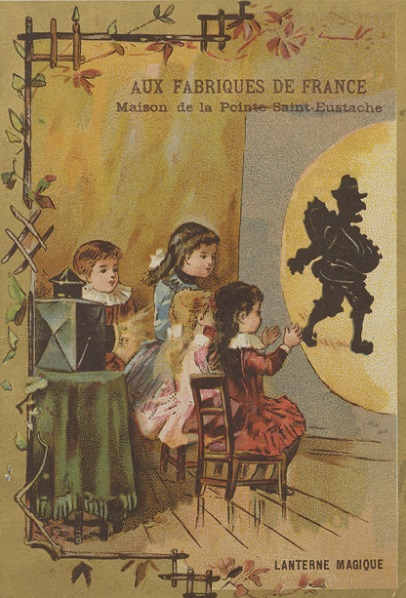
Artist Unknown, (Magic Lantern Trade Card), C.19th century, Lithograph, Collection of Tokyo Photographic Art Museum
The Magic Lantern
A Short History of Light and Shadow
Aug. 14—Oct. 14, 2018
- Aug. 14—Oct. 14, 2018
- Closed :Monday (however open on Sep.17, Sep.24, Oct.1, Oct.8), Sep.18, Sep.25, Oct.9
- Admission:Adults ¥500/College Students ¥400/High School and Junior High School Students, Over 65 ¥250
In recent years projection mapping, public viewing, etc., has meant that the act of watching images in the company of other people has become more common, but when and how did this first become established in society? The concept of using a projector to shine an image on a screen or wall dates back long before the invention of modern cinema to the invention of the magic lantern; this was the earliest form of projector and its popularity soon spread around the world. In this exhibition we will look at the history of imagery from the viewpoint of projection history to shine a light on a new aspect of image history.
The Tokyo Photographic Art Museum possesses a large collection of items connected with the early days of imagery, including various magic lanterns and other apparatus or materials dating back to before the birth of the cinema. In Japan, devices employing light and shadow to create a beautiful, mysterious world have a long history and are known of familiarly by a variety of names, such as utsushi-e (shadowgraph), nishiki kage-e (colored shadow pictures), gento (magic lantern), etc. In this exhibition we will introduce the history of images that are created through light and shadow, focusing on exhibits from our collection and starting with the magic lantern. In addition we will look at the history of optical instruments or visual apparatus that have recently received attention under the titles of ‘visual culture history studies’ or ‘media archaeology’, introducing the results of the latest research to look back over the history of imagery and think about visual expression and image culture today.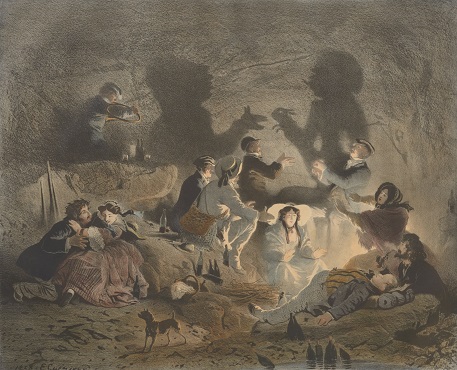
Eugène Charles François Guérard, Les Touristes #18: Déjeuner dans la trou de la Sorcière (Forêt noire.) c. 1854, Lithograph, hand colored
1. The Birth of Magic Lantern
The magic lantern is a projection device that was invented by Christiaan HUYGENS in the Netherlands during the mid-seventeenth century. It gradually spread throughout Europe during the eighteenth century; its applications were diverse, from academic use as a scientific apparatus like microscopes or telescopes, to an attraction employed by showmen or strolling entertainers, and it played an important role in the acceptance and spread of the concept of ‘projection’. The popularity of the shadowgraph in France and Germany during the eighteenth century also served to promote the popularity of the magic lantern. In this section we will introduce the image culture created through shadow and light that was to lay the groundwork for the popularity of the magic lantern, focusing on shadow pictures and phantasmagoria.*
*Phantasmagoria were a form of horror show employing a magic lantern that first appeared at the end of the eighteenth century. It used a special form of lantern, known as a fantascope, that was hidden from the audience and used to project frightening images of ghosts or phantoms. It is famous for having taken Paris by storm.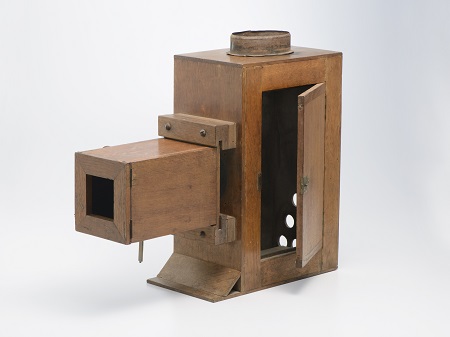
(Fantascope Molteni), 1830-50, Wood, brass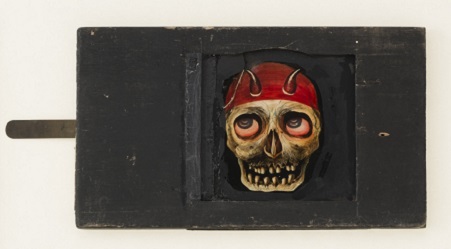
(Slides for fantasmagoria), 1830-50, Glass, wood, brass
2. Magic Lantern Mania
At the beginning of the nineteenth century the popularity of the magic lantern reached new heights, leading to the appearance of simple devices that were available at prices allowing them to be bought and operated by ordinary households. In addition, whether they were used for science or entertainment, the lenses or light sources were improved, shutters added and their function as projectors steadily enhanced. This section will be divided into three sections: ‘The Eye of Science’, ‘entertainment’ and ‘Games at Home’, to introduce the various types of magic lanterns that were produced for different purposes.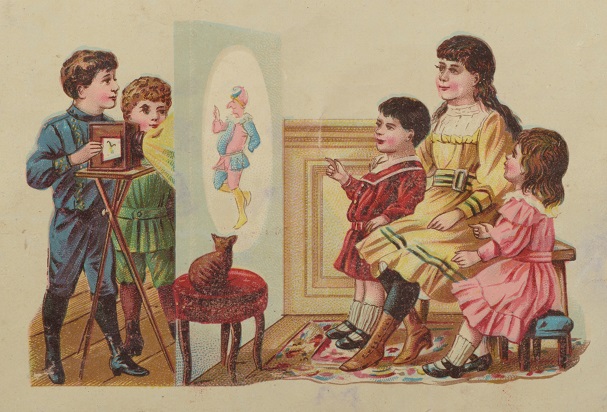
Artist Unknown, (Magic Lantern Trade Card), C.19th century, Lithograph
3. Magic Lantern in Japan
It is known that the magic lantern first entered Japan during the Edo period (1603–1868). As they are eminently suitable for displays or theater, they were initially enjoyed as a rare form of Dutch entertainment and underwent unique forms development throughout the country. When they were first introduced, they were given a numerous different names, such as ‘kage-e tōrō (shadow picture lantern), or ‘genyōkyō (phantom revealing mirror), as people searched for a suitable word based on the existing culture to describe a device for projecting images. Later, they came to be called by different names in different regions: utsushi-e (projection picture) in the regions surrounding Edo (Tokyo) and nishiki kage-e (colored shadow picture) around Kyoto. With the advent of the Meiji period in 1868 the magic lantern was promoted as the latest educational aid and named gentō (magic lantern). At around this time, the woodblock print artist, Yōshū Chikanobu, produced a work entitled ‘Gentō shashin kurabe—Kanjinchō’ (Daydreams by Magic Lantern Slide Series—Kanjinchō), which depicts a young woman yearning for an actor, combined with a magic lantern image of him performing in a play. From this we can see that for a long period, magic lanterns were popular throughout the world, their image technology capturing the imaginations of the people.
4. Slides
Magic lanterns generally used glass slides with pictures painted on them. The collection of the Tokyo Photographic Art Museum contains a variety of slides including those depicting ghosts and angels from phantasmagoria, those which used some mechanism to make the image move, and some which are not painted but have photographs printed on them. Some of the slides are of text, describing the story being shown, and these would have been read out to the audience by a narrator or performer, allowing us a glimpse of what the shows must have been like.
Chromatropes, C.19th century, Glass, colored, wood or brass, tinplate, etc.
5. After the Magic Lantern
Approximately two hundred years after the invention of the magic lantern, the Lumière brothers invented the first motion picture technology that they called cinématographe. Cinema can be said to be a new form of the projection culture that had developed from the magic lantern. This section will present works and exhibits dating from the earliest days of filmmaking, show the relationship that exists between the magic lantern and contemporary video works, and introduce a projection work by the contemporary artist, Koganezawa Takehito.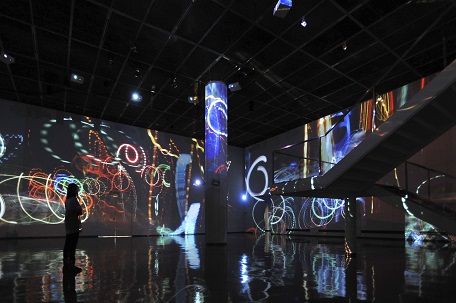
Koganezawa Takehito, installation view of “Between This and That", 2008, video projection
□Sponsored by Toppan Printing Co., Ltd.
Have Fun, Collect, ‘TOP Stamp Rally’
In addition to enjoying three exhibitions, visitors can also participate in the TOP Museum stamp rally to receive TOP original goods.
The object is to collect stamps after viewing the featured exhibitions in order to receive original goods.
* Stamp Rally period: May 12, (Sat.) – November 4, (Sun.)2018
* Stamp card issued: May 12, (Sat.) – October 14, (Sun.)2018
* Exchange period: August 11, (Sat. Holiday) – November 4, (Sun.)2018


![チラシ1[pdf]](http://topmuseum.jp/upload/4/3084/thums/magic lantern.png)
![出品作品リスト1[pdf]](http://topmuseum.jp/upload/4/3084/thums/top_MagicLantern_list-8p_0803-3.png)